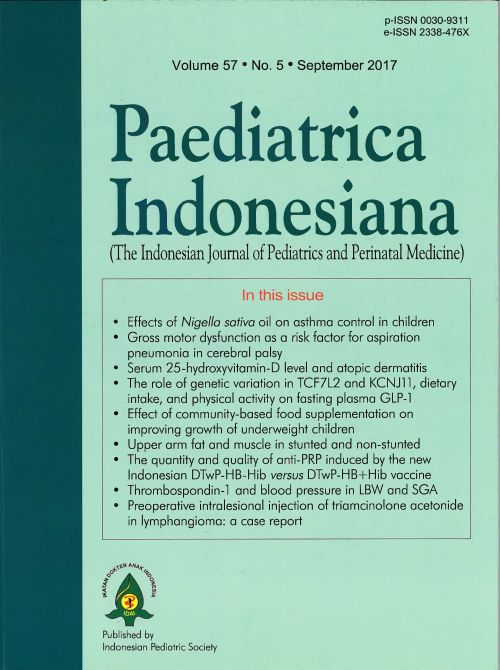Gross motor dysfunction as a risk factor for aspiration pneumonia in children with cerebral palsy
DOI:
https://doi.org/10.14238/pi57.5.2017.229-33Keywords:
aspiration, pneumonia, cerebral palsyAbstract
Background Respiratory problems, such as aspiration pneumonia, are major causes of morbidity and mortality in children with cerebral palsy (CP) and greatly affect the quality of life of these children. Nevertheless, there is limited data on the incidence and risk factors of aspiration pneumonia in children with CP in Indonesia.
Objective To determine the incidence and risk factors of aspiration pneumonia in children with cerebral palsy.
Methods In children with CP aged 1-18 years, incidence of pneumonia was studied prospectively for 6 months and the prevalence of the risk factors was studied cross-sectionally. At baseline, we evaluated subjects’ by history-taking, physical examination, risk factors, and chest X-ray to assess the incidence of silent aspiration. Subjects were followed-up for six months to determine the incidence of overt or silent aspiration pneumonia.
Results Eight out of 36 subjects had one or more episodes of aspiration, consisting of silent aspiration (2/36) and clinically diagnosed aspiration pneumonia (7/36). Subjects with more severe gross motor dysfunction experienced more episodes aspiration pneumonia, although it was not statistically significant (p = 0.06), while dysphagia (P=0.2) and nutritional status (P=0.11) were not associated with pneumonia or silent aspiration.
Conclusion Twenty-five percent of children with CP experienced aspiration pneumonia during the 6-month study period, with gross motor dysfunction as a possible risk factor.
References
2. Seddon PC, Khan Y. Respiratory problems in children with neurological impairment. Arch Dis Child. 2003;88:75–8.
3. Polednak AP. Respiratory disease mortality in an institutionalised mentally retarded population. J Ment Defic Res. 1975;19:165-72.
4. Calis E. Correlates of lower respiratory tract infections and nutritional state in children with severe generalized cerebral palsy and intellectual disability [dissertation]. [Rotterdam]: Erasmus Universiteit; 2011.
5. Sheppard JJ. Dysphagia disorders survey and dysphagia management staging scale, users manual and test forms revised. New Jersey: Nutritional Management Associates; 2002. p.???
6. Chounti A, Hägglund G, Wagner P, Westbom L. Sex differences in cerebral palsy incidence and functional ability: a total population study. Acta Paediatr. 2013;102:712-7.
7. Rahmat D, Mangunatmadja I, Tridjaja B, Tambunan T, Suradi R. Prevalence and risk factors for epilepsy in children with spastic cerebral palsy. Paediatr Indones. 2010;50:11-7.
8. Arvedson J, Rogers B, Buck G, Smart P, Msall M. Silent aspiration prominent in children with dysphagia. Int J Pediatr Otorhinolaryngol. 1994;28:173–81.
9. Rogers B, Arvedson J, Buck G, Smart P, Msall M. Characteristics of dysphagia in children with cerebral palsy. Dysphagia. 1994; 9: 69–73.
10. Marik PE. Aspiration pneumonitis and aspiration pneumonia. N Engl J Med. 2001;344:665-71
11. Stark C, Nikopoulou-Smyrni P, Stabrey A, Semler O, Schoenau E. Effect of a new physiotherapy concept on bone mineral density, muscle force and gross motor function in children with bilateral cerebral palsy. J Musculoskelet Neuronal Interact. 2010;10:151-8.
12. Ketelaar M, Vermeer A, Hart H, van Petegem-van Beek E, Helders PJ. Effects of a functional therapy program on motor abilities of children with cerebral palsy. Phys Ther. 2001;81:1534-45.
13. Reilly S, Skuse D, Poblete X. Prevalence of feeding problems and oral motor dysfunction in children with cerebral palsy: a community survey. J Pediatr. 1996;129:877-82.
14. Lefton-Greif MA, Carroll JL, Loughlin GM. Long-term follow-up of oropharyngeal dysphagia in children without apparent risk factors. Pediatr Pulmonol. 2006;41:1040–8.
15. Bell KL, Boyd RN, Tweedy SM, Weir KA, Stevenson RD, Davies PS. A prospective, longitudinal study of growth, nutrition and sedentary behaviour in young children with cerebral palsy. BMC Public Health. 2010;10:179-91.
16. Rogers SL, Coe CL, Karaszewski JW. Immune consequences of stroke and cerebral palsy in adults. J Neuroimmunol. 1998;91:113-20.
17. Kuperminc MN, Stevenson RD. Growth and nutrition disorders in children with cerebral palsy. Dev Disabil Res Rev. 2008;14:137–46.
18. Sjakti HA, Syarif DR, Wahyuni LK, Chair I. Feeding difficulties in children with cerebral palsy. Paediatr Indones. 2008;48:224-9.
19. May WL, Win H, Linn K, Oo K, Kyi S, Phyu AH, Pau DL. Nutritional status of children with cerebral palsy in cerebral palsy clinic, Yangon children’s hospital. Myanmar Health Sci Res J. 2014;26:22-7.
Downloads
Published
How to Cite
Issue
Section
License
Authors who publish with this journal agree to the following terms:
Authors retain copyright and grant the journal right of first publication with the work simultaneously licensed under a Creative Commons Attribution License that allows others to share the work with an acknowledgement of the work's authorship and initial publication in this journal.
Authors are able to enter into separate, additional contractual arrangements for the non-exclusive distribution of the journal's published version of the work (e.g., post it to an institutional repository or publish it in a book), with an acknowledgement of its initial publication in this journal.
Accepted 2017-10-16
Published 2018-01-05


















